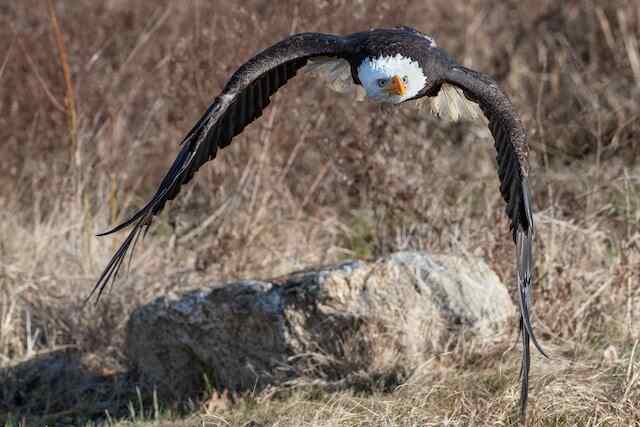Do Eagles Eat Chickens? The age-old mystery that has poultry farmers flapping their wings! Birds of prey have long been associated with “ruffling feathers,” symbolizing disruption and unrest. But what about the regal eagle?
In this article, we dive into the intricate world of avian biology to uncover whether these powerful and graceful creatures have a taste for our clucking companions.
Explore the evidence, learn about eagle hunting techniques, and discover strategies to protect your chickens in an environment that promotes their freedom.
Get ready for a feathery adventure that will leave you clucking with anticipation!
Table of Contents
- 1 Key Takeaways
- 2 Understanding the Diet of Eagles
- 3 Do Eagles Eat Chickens
- 4 The Relationship Between Eagles and Chickens
- 5 Identifying Signs of Eagle Presence
- 6 Protecting Your Chickens from Eagle Attacks
- 7 Creating a Predator-Proof Environment
- 8 Training and Supervising Your Chickens
- 9 Utilizing Guard Animals
- 10 Implementing Visual Deterrents
- 11 Seeking Assistance from Wildlife Professionals
- 12 Frequently Asked Questions
- 12.1 How can I train my chickens to stay away from eagles?
- 12.2 What are some effective visual deterrents to keep eagles away from my chickens?
- 12.3 Should I seek assistance from wildlife professionals if I suspect an eagle attack on my chickens?
- 12.4 How can I identify signs of eagle presence in my area?
- 12.5 What are some common guard animals that can help protect my chickens from eagle attacks?
- 13 Conclusion
- 14 Author
Key Takeaways
- Eagles primarily feed on fish, small mammals, and carrion, but they have been known to prey on chickens.
- Creating a predator-proof environment is important in safeguarding chickens from eagle attacks.
- Guard animals such as geese and dogs can be used to deter eagle attacks on chickens, with geese being particularly effective due to their territorial behavior and instinct to protect their flock.
- Seeking assistance from wildlife professionals and collaborating with experts in eagle conservation can provide valuable knowledge and guidance in understanding eagle behavior and developing effective strategies to mitigate conflicts between eagles and chicken populations.

Understanding the Diet of Eagles
The dietary preferences of eagles have long intrigued researchers and wildlife enthusiasts alike. Eagles, being apex predators, play a crucial role in maintaining the balance of ecosystems.
Their feeding habits are characterized by a wide range of behaviors and hunting techniques. Eagles are known for their exceptional eyesight, which enables them to spot potential prey from great distances.
They employ various hunting strategies, such as aerial attacks, swooping down from great heights, or ambushing their prey from perches.
While eagles primarily feed on fish and small mammals, their diets can vary depending on their geographic location and prey availability.
The relationship between eagles and chickens, however, is a complex one.
While eagles have been known to prey on chickens in some instances, their preference for other food sources and the availability of alternative prey often limits such interactions.
Do Eagles Eat Chickens
Yes, eagles are known to eat chickens. Eagles are opportunistic predators and have a varied diet, which can include small mammals, fish, and birds. C
Chickens are within their prey range, especially for smaller eagle species. Eagles are skilled hunters and can swoop down to snatch chickens with their sharp talons.
The Relationship Between Eagles and Chickens
One can explore the dynamic between eagles and chickens by examining their dietary habits. Eagles are opportunistic predators, known for their remarkable hunting skills and adaptability.
Their behavior in relation to chickens is influenced by various factors, including their natural diet preferences and the availability of alternative prey.
Eagles primarily feed on small mammals, fish, and carrion, but they also occasionally target birds, including chickens, especially when other food sources are scarce.
However, it is important to note that eagles do not solely rely on chickens as their primary food source.
The relationship between eagles and chickens can be a concern for poultry owners, who often implement measures to ensure chicken coop security.
Understanding the complex behaviors and ecological impacts of eagles in different environments is crucial for effectively managing and mitigating conflicts between eagles and chickens.
Identifying signs of eagle presence can help poultry owners take appropriate precautions to protect their livestock.
Identifying Signs of Eagle Presence
Identifying signs of eagle presence can create a sense of urgency and concern among poultry owners, prompting them to take necessary precautions to safeguard their valuable livestock.
To help poultry owners in this endeavor, here are four key signs to look for when determining the presence of eagles in the vicinity of chicken coops:
- Feathers and remains: Eagles are known to leave behind feathers and remains of their prey near their hunting grounds, providing a telltale sign of their presence.
- Disturbed surroundings: Eagles often cause disturbance in their surroundings while hunting, leaving behind signs such as displaced vegetation or disturbed ground.
- Unusual behavior of chickens: When eagles are in close proximity, chickens may exhibit signs of distress, such as increased agitation, huddling together, or attempting to seek shelter.
- Sightings of eagles: Direct sightings of eagles flying or perching nearby are clear indications of their presence.
Understanding eagle behavior and their preferred habitats is crucial in protecting chickens from potential attacks.
By being aware of their natural diet, hunting patterns, and ecological impact, poultry owners can implement effective strategies to safeguard their chickens without resorting to drastic measures.
Transitioning to the next section, it is important to explore methods of protecting chickens from eagle attacks.

Protecting Your Chickens from Eagle Attacks
Implementing effective protective measures is crucial in ensuring the safety of poultry from potential attacks by eagles.
To better understand the strategies for protecting chickens, it is essential to consider the natural diet and behaviors of eagles.
Eagles are opportunistic predators and their diet consists mainly of fish, small mammals, and birds.
While chickens are not a primary food source for eagles, they may occasionally target them if other prey is scarce.
Creating a predator-proof environment is an effective strategy to safeguard chickens from eagle attacks.
This involves constructing secure enclosures with strong fencing, covering the top to prevent aerial attacks, and using deterrents such as scare devices or visual barriers.
By implementing these measures, chicken owners can significantly reduce the risk of eagle predation and ensure the well-being of their flock.
Creating a Predator-Proof Environment
Constructing secure enclosures and implementing deterrents are essential measures for creating a predator-proof environment to safeguard poultry from potential attacks.
To create a secure coop, it is important to consider the natural behaviors and hunting patterns of eagles.
Eagles are opportunistic predators and are known to target small animals, including chickens, as part of their diet.
By constructing a coop with sturdy walls and a roof, it can prevent eagles from gaining access to the chickens.
Additionally, using scare tactics such as visual deterrents like scarecrows or predator decoys can help deter eagles from approaching the coop.
It is crucial to understand that the effectiveness of these measures may vary depending on the geographical location and the availability of prey.
By considering these factors and implementing appropriate precautions, poultry owners can significantly reduce the risk of eagle attacks.
Transitioning into the next section, training and supervising your chickens can further enhance their safety and well-being.
Training and Supervising Your Chickens
To ensure the safety of chickens in a predator-prone environment, it is crucial to implement effective training and supervision techniques.
Understanding chicken behavior is essential in developing appropriate training strategies. Chickens have innate instincts that can be honed through positive reinforcement and consistent handling.
By establishing a routine feeding schedule and using treats as rewards, chickens can be trained to follow specific commands and cues.
Additionally, providing a secure and enclosed space for chickens to roam during the day can help minimize the risk of predation.
It is important to note that training alone may not completely eliminate the threat of eagle predation, as eagles possess incredible hunting skills and can adapt to various environments.
However, an understanding of chicken behavior and the implementation of training techniques can significantly reduce the vulnerability of chickens.
Moving forward, utilizing guard animals can provide an additional layer of protection for the flock.
Utilizing Guard Animals
Guard animals, such as dogs or geese, can be effectively utilized to deter eagle attacks on chickens. Training these animals to recognize and respond to the presence of eagles can significantly reduce the risk of predation.
By employing scientific and technical language, ornithologists or avian biologists can explain the importance of using guard animals in deterring eagle attacks, highlighting the natural behaviors and hunting patterns of eagles, as well as the ecological impact of such predation.
Furthermore, an in-depth analysis of factors such as geographic location, prey availability, and the relationship between eagles and chickens in different environments can provide a comprehensive understanding of the effectiveness of utilizing guard animals.
Introducing guard dogs or geese
Geese, known for their aggressive nature and loud honking, have been proposed as a potential alternative to guard dogs for deterring eagles from preying on chickens.
Geese are particularly effective because of their territorial behavior and natural instinct to protect their flock.
They are highly alert and possess excellent eyesight, allowing them to detect potential threats from a distance.
When confronted by a predator like an eagle, geese will emit loud honks and flap their wings aggressively to scare it away.
This response is rooted in their instinctual defense mechanism to protect their young and territory. Additionally, geese have a strong bond with their flock, making them highly motivated to defend it.
While guard dogs can be trained to deter eagle attacks, geese offer a natural and effective alternative that requires less training and maintenance.
Transitioning into the subsequent section about training animals to deter eagle attacks, it is important to explore the various methods used in guard dog training and how they can be adapted for geese.
Training animals to deter eagle attacks
Animals trained to deter eagle attacks can provide a sense of security and peace of mind for poultry farmers, knowing that their flocks are protected.
Training techniques for these animals involve leveraging predator-prey dynamics to create a deterrent effect.
One effective method is to introduce guard dogs or geese into the poultry farm.
Guard dogs are trained to patrol the area and bark loudly when they sense the presence of an eagle, while geese are known to be territorial and aggressive towards potential threats.
By utilizing these natural instincts, farmers can reduce the risk of eagle attacks on their chickens.
In the predator-prey relationship, eagles are opportunistic hunters and are known to feed on a variety of prey, including chickens.
However, it is important to note that eagles primarily target small mammals, fish, and other birds in their natural diet.
The predation of chickens by eagles is more likely to occur in areas where natural prey is scarce or when chickens are easily accessible.
Factors such as geographic location and prey availability play a significant role in determining the frequency of eagle attacks on poultry.
Implementing visual deterrents, such as scarecrows or reflective materials, can further enhance the effectiveness of animal training in deterring eagle attacks.
These visual deterrents exploit the eagle’s visual acuity and instinctual fear response, making the area less attractive for hunting.
By implementing a combination of training techniques and visual deterrents, poultry farmers can significantly reduce the risk of eagle predation on their chickens, ensuring the safety and well-being of their flocks.
Implementing Visual Deterrents
Implementing visual deterrents can be an effective method to discourage eagles from preying on chickens.
Research has shown that visual cues can disrupt the hunting patterns of eagles by creating a sense of danger or unfamiliarity.
For example, using scarecrows, reflective objects, or motion-activated devices can startle eagles and make them think twice before approaching chicken coops.
These visual deterrents work by exploiting the natural instinct of eagles to avoid potential threats or unfamiliar objects in their surroundings.
However, it is important to note that the effectiveness of visual deterrents may vary depending on various factors, such as the species of eagle, the geographical location, and the availability of alternative prey.
Therefore, it is recommended to seek assistance from wildlife professionals to determine the most suitable visual deterrents for specific situations and to ensure the overall success of the predator control measures.

Seeking Assistance from Wildlife Professionals
Contacting local wildlife services and collaborating with experts in eagle conservation are essential steps in seeking assistance with managing the interaction between eagles and chickens.
Local wildlife services can provide valuable guidance and support in understanding the behavior and habits of eagles in specific regions, as well as offer strategies for deterring eagles from preying on chickens.
Collaborating with experts in eagle conservation, such as ornithologists or avian biologists, can provide in-depth knowledge and expertise on the feeding habits of eagles, their natural diet, and hunting patterns.
By working with these professionals, individuals can gain a comprehensive understanding of the ecological impact of eagles and make informed decisions to mitigate conflicts with chicken farming.
Contacting local wildlife services
Local wildlife services can serve as a valuable resource for individuals seeking information on the dietary preferences of eagles in relation to chickens.
Ornithologists and avian biologists, who possess specialized knowledge in the field of birds, can provide accurate and detailed information about this topic.
They can explain the natural diet of eagles, their hunting patterns, and the ecological impact of their feeding habits.
Factors such as geographic location, prey availability, and the relationship between eagles and chickens in different environments are also taken into consideration.
When contacting authorities or reporting eagle sightings, individuals can expect to receive objective and factual information based on scientific evidence and research.
By collaborating with experts in eagle conservation, individuals can further deepen their understanding of the complex dynamics between eagles and chickens.
Collaborating with experts in eagle conservation
To better understand the interaction between eagles and chickens, it is essential to collaborate with experts in eagle conservation.
Ornithologists and avian biologists possess the knowledge and expertise required to provide accurate and detailed information about the feeding habits of eagles.
By collaborating with these experts, we can gain insights into the natural diet of eagles, their hunting patterns, and their ecological impact.
This collaboration allows for a more in-depth analysis of the topic, considering factors such as geographic location and prey availability.
Research findings suggest that while eagles primarily feed on fish and small mammals, they may opportunistically prey on chickens in certain circumstances.
However, the extent of this interaction varies depending on the specific environment and the availability of alternative prey.
Understanding these dynamics is crucial for developing effective strategies to mitigate potential conflicts between eagles and chicken populations.
Frequently Asked Questions
How can I train my chickens to stay away from eagles?
Training techniques and natural deterrents can help chickens stay away from eagles. Strategies may include providing secure enclosures, using visual scare devices, and employing predator-specific deterrents. Understanding the natural behaviors and diet of eagles is crucial for effective prevention methods.
What are some effective visual deterrents to keep eagles away from my chickens?
Effective visual deterrents to keep eagles away from chickens include scarecrows, reflective tape, predator decoys, and motion-activated lights. These methods exploit the visual sensitivity of eagles and disrupt their hunting patterns, reducing the risk of predation on chickens.
Should I seek assistance from wildlife professionals if I suspect an eagle attack on my chickens?
Seeking professional advice is recommended if one suspects an eagle attack on chickens. Ornithologists or avian biologists can provide in-depth analysis on deterrent strategies, considering factors such as natural diet, hunting patterns, and ecological impact.
How can I identify signs of eagle presence in my area?
Identifying eagle presence in an area involves observing specific behavioral patterns. Ornithologists analyze factors like natural diet, hunting patterns, and ecological impact to determine the likelihood of eagles preying on chickens in different environments, considering geographic location and prey availability.
What are some common guard animals that can help protect my chickens from eagle attacks?
Guard animals such as dogs, llamas, and donkeys can help protect chickens from eagle attacks by providing a deterrent presence. These animals are known to exhibit territorial behaviors, which can discourage eagles from approaching chicken coops and enclosures.

Conclusion
In conclusion, it is evident from scientific research and evidence that eagles do indeed have the capacity to prey on chickens.
However, it is important to note that eagle attacks on chickens are relatively rare and occur primarily in areas where eagles and chickens coexist in close proximity.
By implementing proper measures such as creating a predator-proof environment, training and supervising chickens, utilizing guard animals, implementing visual deterrents, and seeking assistance from wildlife professionals, chicken owners can significantly reduce the risk of eagle attacks and protect their flock.




